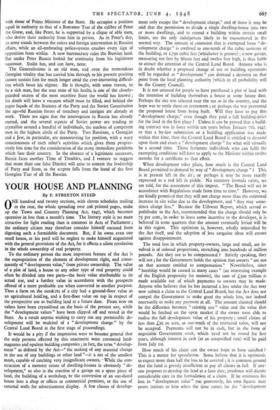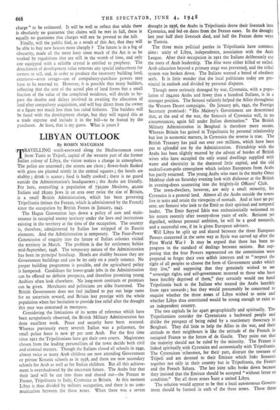YOUR HOUSE AND PLANNING
By F. STREETON STEED
ONE hundred and twenty sections, with eleven schedules trailing in the rear, the whole spreading over 206 printed pages, make up the Town and Country Planning Act, 1947, which becomes operative in less than a month's time. The literary style is no more attractive for light reading than is common in Acts of Parliament ; the ordinary citizen may therefore consider himself excused from digesting such a formidable document. But, if he owns even one small house, at his peril will he neglect to make himself acquainted with the general provisions of the Act, for it effects a silent revolution in the whole ownership of real property.
To the ordinary person the most important feature of the Act is the expropriation of the element of development right, and conse- quently of "development value," from private ownership. The value of a plot of land, a house or any other type of real property could often be divided into two parts—the basic value attributable to its actual use, and a further value in accordance with the proipects offered of a more profitable use when converted to another purpose. Thus a farm on the outskirts of a city had a ground-floor value as an agricultural holding, and a first-floor value on top in respect of the prospective use as building land at a future date. From now on values have been crystallised on the basis of the present use, while the "development values" have been clipped off and vested in the State. As a result anyone wishing to carry out any permissible de- velopment will be mulcted of a "development charge" by the Central Land Board at the first stage of proceedings.
It would be a pity if the impression were to become general that
the only persons affected by this enactment were coroneted land- magnates and opulent building companies ; in fact, the term " develop- ment " as defined by the Act—" the making of any material change in the use of any buildings or other land "—ic a net of the smallest mesh, capable of catching very insignificant owners. • While the con- struction of a monster estate of dwelling-houses is obviously "de- velopment," so also is the erection of a garage on a spare piece of land, the boil/ling of a workshop, or the conversion of an out-dated house into a shop or offices or commercial premises, or the use of external walls for advertisement display. A few classes of develop-
meat only escape the "development charge," and of these it may be said that the permission to divide a single dwelling-house into two or more dwellings, and to extend a building within certain small limits, are the only indulgences likely to be encountered in the normal way. The amount of extension that is exempted from "de- velopment charge" is confined to one-tenth of the cubic contents of the building, or 1,750 cubic feet (whichever is greater) ; a new garage, measuring ten feet by fifteen feet and twelve feet high, is thus liable to attract the attention of the Central Land Board. Anyone who is in doubt whether a proposed change of use or building operations will be regarded as " development " can demand a decision on that point from the local planning authority (which in all probability will be the County Council).
It is not unusual for people to have purchased a plot of land with the intention of building themselves a house at some future date. Perhaps the site was selected near the sea or in the country, and the hope was to settle there on retirement ; or perhaps the war prevented the proposed house from being built. Will they have to pay this "development charge," even though they paid a full building-price for the land in the first place ? Unless it can be proved that a build- ing contract was in force within ten years before January 7th, 1947, or that a by-law submission or a building application was made within that time, then the Central Land Board is entitled to descend upon them and exact a "development charge" for what will virtually be a second time. Those fortunate individuals who can fulfil the exempting conditions will have to apply to the Minister within twelve months for a certificate to that effect.
When development takes place, how much is the Central Land Board permitted to demand by way of "development charge " ? This is at present left in the air ; or perhaps it may be more exactly expressed as a rod left in pickle. No statutory formula exists, we are told, for the assessment of this impost. "The Board will act in accordance with Regulations made from time to time." However, we are kindly promised that they will not charge more than the estimated increase in site value due to the development, and "they may some- times charge less." Because the Uthwatt Report, which served as pathfinder to the Act, recommended that the charge should only be 75 per cent., in order to leave some incentive to the developer, it is believed in some quarters that the amount eventually levied will be in this region. This optimism is, however, wholly unjustified by the Act itself, and the adoption of Jess sanguine ideas will ensure against disappointment.
The total loss in which property-owners, large and small, are in- volved is of colossal proportions, stretching into hundreds of million pounds. Are they not to be compensated ? Strictly speaking, they will not ; for the Government holds the opinion that owners "are not on that account entitled to compensation." Nevertheless, since "hardship would be caused in many cases" (an interesting example of the English propensity for meiosis), the sum of L300 million is made available out of which payments to owners may be made. Anyone who believes that he has incurred a loss under the Act may now submit a claim to the Central Land Board, but the Act does not compel the Government to make good the whole loss, nor indeed necessarily to make any payment at all. The amount claimed should be the difference between "exist* use" value and the value that would be fetched on the open market if the owner were able to realise the full development value of his property ; small claims of less than £20 an acre, or one-tenth of the restricted value, will not be accepted. Payments will not be in cash, but in the form of negotiable Government stock, which need not be issued for five years, although interest in cash (at an unspecified rate) will be paid from July 1st.
How much of his claim can the owner hope to have satisfied ? This is a matter for speculation. Some believe that it is optimistic to expect more than half the loss to be covered ; it is common ground that the fund is grossly insufficient to pay all claims in full. If any- one proposes to develop the land at a later date, prudence will dictate considerable care in the formulation Of a claim. If he estimates his loss in "development value" too generously, his own figures may prove traitors to him when the time comes for the "development charge" to be estimated. It will be well to reflect that while there is absolutely no guarantee that claims will be met in full, there is equally no guarantee that charges will not be pressed to the hilt.
Finally, will the public find, as a result of this Act, that they will be able to buy new houses more cheaply ? The future is in a fog of obscurity, made all the more hazy since much of the Act is to be worked by regulations that are still in the womb of time, and only one equipped with a reliable crystal is entitled to prophesy. The detachment of development value removes any special inducement for owners to sell, and, in order to produce the necessary building land, extensive—even savage—use of compulsory-purchase powers may have to be resorted to. However, it is possible that many builders, reflecting that the cost of the actual plot of land forms but a small fraction of the value of the completed residence, will decide to by- pass the doubts and delays involved in awaiting the allocation of land after compulsory acquisition, and will buy direct from the owner at a figure not much less than has ruled hitherto. The builders will be faced with the development charge, but they will regard this as a trade expense and include it in the bill—to be footed by the purchaser. At least, that is my guess. What is yours ?



































 Previous page
Previous page